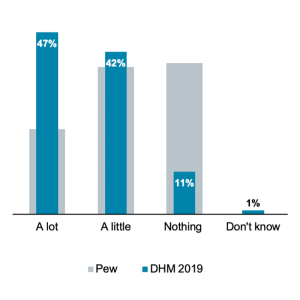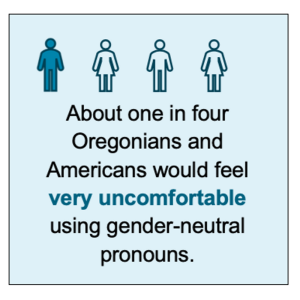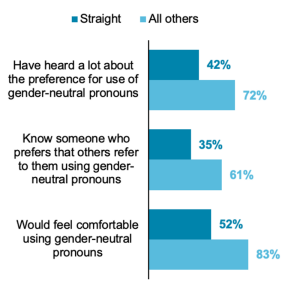While Western culture has long articulated gender as a binary between men and women (in that order, unfortunately), there have always been people whose identities are not accounted for by this framing. In 2017, Oregon recognized non-binary and gender non-conforming people by becoming the first state to allow a third category of “X” on driver licenses and identification cards.
Non-binary and gender non-conforming people often prefer that others use gender-neutral pronouns such as “they” instead of “he” or “she” when referring to them. This month, we wanted to see how Oregonians compare to the rest of the country when it comes to exposure, familiarity, and comfort with the use of gender-neutral pronouns.
These findings come from the September 2019 fielding of our DHM Panel. The survey was conducted September 10–18, 2019, and surveyed 562 Oregonians. The results were weighted by age, gender, area of the state, political party, and level of education to ensure a representative sample of Oregon voters. The margin of error for this survey is ±4.4%. National data comes from a survey done by Pew Research Center published in January 2019.
Oregonians are more familiar and more comfortable with the use of gender-neutral pronouns than Americans.

Oregonians (47%) are more than twice as likely to say they have heard a lot about gender-neutral and non-binary pronouns than Americans (22%). Additionally, the number of Oregonians (11%) who say they haven’t heard anything about people using gender-neutral pronouns is less than one-third that of Americans who say the same (39%). While the difference is not as stark, Oregonians (37%) are also more likely than Americans (30%) to personally know someone who prefers that others use gender-neutral pronouns when referring to them.
Oregonians (37%) are also more likely than Americans (30%) to say they would feel very comfortable using gender-neutral pronouns if asked to do so. While a majority of Oregonians and Americans would feel comfortable, about one-quarter of all respondents in both groups reported that they would feel very uncomfortable.
Familiarity may be an important factor in determining comfort. Oregonians’ who know someone personally who prefers to go by gender-neutral pronouns are more likely to both have heard a lot about the preference (83%) and to feel comfortable using gender-neutral pronouns (73%)

Exposure, familiarity, and comfort vary based on demographic differences of Oregonians.
Religion is an important factor in determining Oregonians’ level of familiarity and comfort with the use of gender-neutral pronouns. Atheist, agnostic, and others without religious affiliations (45%) are more likely to know someone who prefers to go by gender-neutral pronouns than their Protestant or Roman Catholic counterparts (20%). These Oregonians are also more likely to feel comfortable using gender-neutral pronouns (67% vs. 39%). In addition to religious affiliation, religious salience impacts how comfortable Oregonians feel using gender-neutral pronouns. One-third of those who say religion is important to them (33%) would feel very uncomfortable, compared to only 12% of those who say religion is not important.
Age is also an important factor, with younger Oregonians, those between the ages of 18 and 54 (53%–79%), more likely than their older counterparts (30%) to have been exposed to the preference for use of gender-neutral pronouns.
Trends in political ideology and sexual orientation can be seen across all three items: exposure, familiarity, and comfort. Those with a liberal political ideology are more likely than their counterparts to have heard a lot about (57%), to know someone who prefers (55%), and to be comfortable with (84%), the use of gender-neutral pronouns than their conservative or moderate counterparts. The same trends exist for those whose sexual orientation is something other than straight, as show in the chart.
